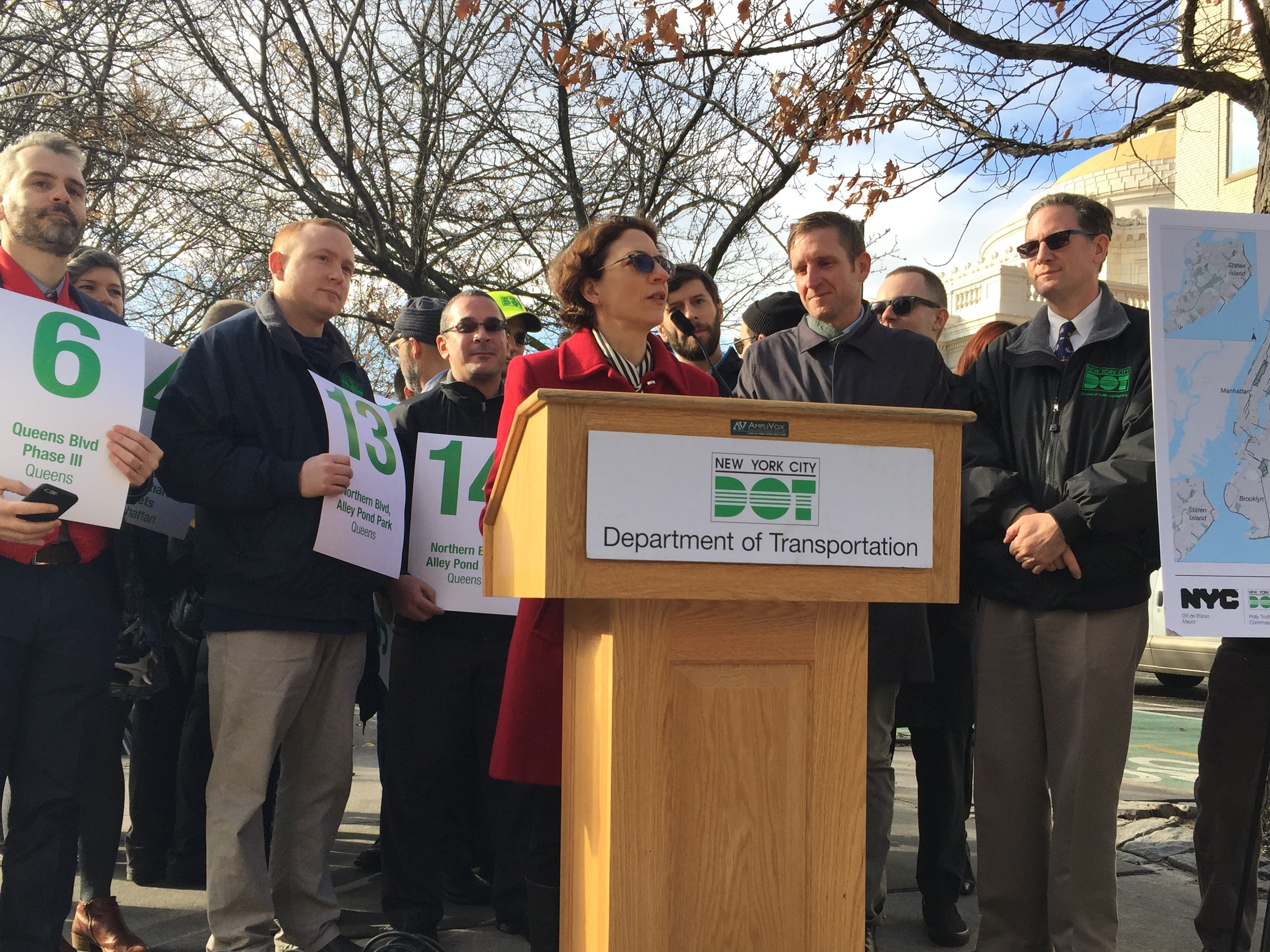DOT installed 25 miles of protected bike lanes in 2017, the agency announced today, with much of the growth consisting of new two-way protected lanes in Queens. The agency counts each side of a two-way bike lane toward its mileage tally, which factored into this year's record-setting total.
"Our bike lane network has grown in leaps and bounds," Transportation Commissioner Polly Trottenberg said at a press event on the Brooklyn side of the Williamsburg Bridge. DOT recently installed protected bike lanes on the bridge approach in advance of the L train shutdown, during which the city expects daily bike crossings to double or even triple.
Other new protected bike lane segments installed this year include Park Row outside City Hall, 138th Street in the Bronx, and Seventh Avenue in Manhattan. Much of the action has been in central and eastern Queens, in neighborhoods that didn't have any protected bike lanes until this year.
A two-way protected bike lane made 111th Street in Corona a safe neighborhood access point to Flushing Meadows Corona Park, and the latest phase of the Queens Boulevard redesign extended protected bike lanes to Rego Park. The biggest bike project of the year added several miles of protected bike infrastructure on streets around Alley Pond Park, including a segment on Northern Boulevard that calmed a notoriously dangerous but unavoidable cycling connection to the Joe Michaels Mile path.
The slate of 2017 protected bike lane projects also included several shorter segments throughout the five boroughs to strengthen links in the city's bicycle network.
The growth of protected bike lanes has coincided with a steady increase in bicycling by New Yorkers. This year was no exception, according to DOT Senior Director of Bicycle and Pedestrian Programs Sean Quinn. DOT plans to release 2017 cycling numbers next month, he said.
TransAlt Executive Director Paul Steely White praised DOT staff for their productivity and skill at implementing these critical street safety projects. "We advocates can be a real pain in the butt sometimes, but we are humbled by the job [DOT is] doing," White said. "Commissioner Trottenberg and her team are really the best in the country, and maybe the world, at transforming big city streets."
There's still a lot left to do. Cyclist deaths have increased in 2017, according to data compiled by TransAlt, with 23 fatalities so far, not including the victims of the deliberate ramming attack on the West Side Greenway. Last year, 18 people were killed while biking on NYC streets.
Key gaps in the existing protected bike lane network have yet to be filled, particularly in the heart of Midtown. Frustrated with those gaps, TransAlt activists formed "human-protected bike lanes" on Second Avenue and Fifth Avenue to call the mayor's attention to the lack of safe cycling routes in Midtown. Large swaths of the boroughs outside Manhattan also lack protected bike lanes.
On Second Avenue, Quinn said DOT has studied the effect of the recently installed bike lane, which has no parking protection during peak hours, and found an increase in cycling as well as a decrease in crashes with injuries. The agency plans to present that data to the relevant community boards "this winter," with the goal of addressing the existing gaps. He also said the agency plans to propose new bike lanes in Midtown, but didn't reveal further details.
"Commissioner Trottenberg and the DOT deserve a lot of credit for completing a record 25 miles of protected bike lanes this year," White said in a statement released after the press conference. "But given that the number of cyclist deaths is up this year, it's clear that there's still more work to do. We have to redouble our efforts to tackle the city's Vision Zero Priority Corridors in 2018, and we look forward to supporting the DOT as they do that hard work to protect New Yorkers on bikes."






